The quaint Latin term might mean appeal to modesty but in plain English it refers to the fallacy of an appeal to authority.
This form of error is an egregious but effective technique which puts an opponent in the awkward position of appearing to commit the sin of pride if he persists in his opposition. (p.253)
Fischer (Historians’ Fallacies) discusses a 1950’s exchange among historians of modern history to illustrate that “the most crude and ugly form of an argument ad verecundiam in historical writing is an appeal to professional status.” I will cite here a more recent example.
In 2003 George Athas published a version of his 1999 doctoral thesis on the Tel Dan inscription — a 1993 archaeological find that was widely claimed to be the earliest extra-biblical evidence for the House of David. Two of the earliest reviews of this work were “most crude and ugly” indeed:
The authors hope is that his study will do much to quell the unhelpful passion and euphoria that have lured us all into emotional scholarship (319). Those are rather grand and pretentious aims for a doctoral dissertation . . . (Review in RBL 10/2003) by William M. Schniedewind University of California)
And a year later:
. . . . After a decade of extensive research, there was a feeling among scholars that the study of the inscription had reached fruition and that no significant advance could be made, unless more fragments were found in the excavations.
It is against this background that the book under review should be evaluated. The book, a rework of a dissertation submitted to the University of Sydney in 1999, deals with some aspects (notably the epigraphical, paleographical, and textual analysis) in such detail as could be done only in a doctoral dissertation. Considering that Athas is a beginning young scholar, the book is pretentious in the extreme. Athas believes that his study will do much to quell the unhelpful passion and euphoria that the Tel Dan Inscription has evoked among scholars and interested persons alike (319). — (Review in RBL 10/2004 by Nadav Naaman, Tel Aviv University)
I once wrote:
There are many reasons . . . to believe that Acts was composed [as] a later reaction against Marcionism.
No more, just an invitation to discuss the evidence if my debating partner was willing to go there. But his reply was an interesting shut down with his appeal to “modesty” and by inference “my arrogance” for even making such a claim:
That might be a fun debate. … {g} You do realize that such a position (about Acts) goes directly up against evaluations by Adoph Von Harnack and JAT Robertson (among many others on all sides of the theological spectrum, some of them no more poster-boys for Christian “dogmatism” than those two were), right?
In other words, my correspondent was demonstrating a complete lack of interest in what “many reasons” there might possibly be, preferring instead to rest on the works generally cited as authorities. Authority of the names alone was sufficient. The question was recast from one of evidence and reason to one of attitude: of presumed modesty versus a presumption of arrogance.
One might even call it an attempt at “intellectual bullying”.
A favourite arena where this tactic is found is where individuals outside the academy raise questions or challenge paradigms that have long been seen as the special preserve of the academy. Obviously some of those questions and alternate proposals are kooky. But academia does itself — nor the public to whom one would expect it to feel some sense of responsibility — any favours by arrogant appeals “to modesty”.
Fischer concludes:
In historiography, such crude forms of argument ad verecundiam are rarely to be met with — in print, at least. [He was writing in 1970 — before online discussion groups and wikis.] The explanation is not that scholars are gentlemen, but rather, as Bolingbroke noted many years ago, that “those who are not such, however, have taken care to appear such in their writings.”
The above examples demonstrate that Fischer’s observations do not necessarily apply in our times of public online journal reviews and discussions.
P.S.
there exists online another review of Athas’s study sans the “modesty” by Daniel Miller (2007) in the Journal of Hebrew Scriptures.
Like this:
Like Loading...
 Here I look at the argument that the inscription (bytdwd) apparently referring to David (dwd) or the “house of David” in the Tel Dan Inscription is best explained as a reference to an epithet (meaning “beloved”) for the god Yahweh.
Here I look at the argument that the inscription (bytdwd) apparently referring to David (dwd) or the “house of David” in the Tel Dan Inscription is best explained as a reference to an epithet (meaning “beloved”) for the god Yahweh.
